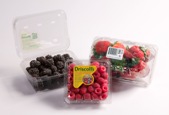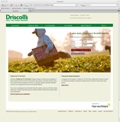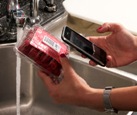

A key component of the brand strategy is Driscoll’s continuous focus on delivering the highest level of food safety through “Good Agriculture Practices” set by the U.S. Food and Drug Administration. The effort is uniformly enforced at all of its farms, cooling and distribution facilities around the world. Now Driscoll’s has developed a way to strengthen the connection between its berries and consumers by making it possible for consumers to trace their Driscoll’s berries back to where they were grown.
To help engage consumers on a more personal level, Driscoll’s created a traceability program called “Follow Us To The Farm,” which is accessible via www.driscsolls.com.
Driscoll’s berries are packaged in clear clamshell containers with a prime label on the lid, and a UPC bottom label that includes a variable two-dimensional code (2-D matrix code) and a corresponding human-readable alphanumeric tracking code. The 2-D matrix and alphanumeric codes are the foundation of the track-and-trace identification system.
To see the region or farm where the berries were harvested, all a consumer has to do is enter the alphanumeric code at the “Follow Us To The Farm” section of the website, www.driscolls.com. A second point of access is available with a downloadable iPhone application, HarvestMark™ Food Traceability, which takes a photo of the 2-D matrix code and brings the consumer directly to the growing region or farmer profile.

“We continue to rapidly expand the level of product coverage with traceable packages,” said Doug Ronan, vice president of marketing for Driscoll’s. “Our ultimate goal is to have every Driscoll’s clamshell traceable to individual farms. “Overall, this program gives consumers confidence and peace of mind knowing they can easily access information about their purchase. And the track-and-trace features of the bottom label have been added at no extra cost to consumers.”
Verifying 100-% accuracy
Since 1992,WS Packaging Group, has produced the prime and bottom labels for Driscoll’s berry products sold in North America. And even though every Driscoll’s farm is not yet in the “Follow Us To The Farm” system, every bottom label must still be verified to be 100-% scannable.
“The biggest challenges in producing the code tracking labels is verifying their scannability, and to print them with minimal lead times,” says Ron Bruneau, vice president of operations for WS Packaging’s West Coast facilities. “We use an on-press-camera scanning system that literally scans every 2-D matrix code to confirm scannability and ensure the label is appropriate in the way it’s printed.”
WS Packaging uses Fasson® Semi-Gloss Elite™ pressure-sensitive paper, fromAvery Dennison, as the facestock for the bottom label. The UPC, 2-D matrix code and human-readable alphanumeric code are printed in one press pass. The label is flexo printed in one color, black on white, with a UV varnish to protect all elements during shipping and handling. The label is variable-image printed with a drop-on-demand ink jet print system.
The work for Driscoll’s is like a three-legged stool-Driscoll’s, WS Packaging and one of four thermoformers that produce the clamshells that package the berries and perform a second level of scannability verification. The thermoformers make the clamshells and apply the WS Packaging labels, and then sell Driscoll’s the cases of labeled clamshell containers.
Strawberries, blackberries and raspberries are packed in the field, while blueberries are handled in a packing facility. Driscoll’s has to know which series of clamshell containers are sent to which farm. A case of clamshells may get shipped directly to a field, or may go to a warehouse where it could be held for sometime before being deployed to a particular field or packing facility.
When the clamshells are cased at the thermoformer, there is no way of knowing where a case is going to end up, so each case is labeled with what is described as a “master case” label having removal “daughter tag” labels. The 2-D code on each clamshell is scanned and recorded as they are put into the case. A unique code is then assigned to the scannable master case label and daughter tags and associated to the individual clamshells. This computer-controlled process establishes a connection between what has been scanned, what is in each case and, ultimately, where each case ends up. WS Packaging also produces the master case labels.
When a case of clamshells goes to a farm, the berry pickers remove the clamshells from the case, and the daughter tag is taken off the case and placed on a special form and scanned. It’s at this point that Driscoll’s knows which case, and its corresponding clamshells, is in that field on that day. When every daughter tag is collected and scanned, Driscoll’s knows what was picked and from which field it was harvested.
WS Packaging produces the track-and-trace labels at its facility in Fullerton, CA. It has produced hundreds of millions of the traceable labels since 2009, covering more than 35 SKUs.
